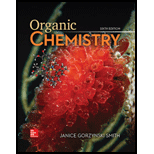
Concept explainers
(a)
Interpretation: The given pair of compounds is to be classified as isomers or resonance structures.
Concept introduction: Isomers are defined as the molecules having the same molecular formula but different arrangement of atoms. The arrangement of atoms in resonance structures remains same but the position of non-bonded electrons and pi bonds is different.
(b)
Interpretation: The given pair of compounds is to be classified as isomers or resonance structures.
Concept introduction: Isomers are defined as the molecules having the same molecular formula but different arrangement of atoms. The arrangement of atoms in resonance structures remains same but the position of non-bonded electrons and pi bonds is different.
(c)
Interpretation: The given pair of compounds is to be classified as isomers or resonance structures.
Concept introduction: Isomers are defined as the molecules having the same molecular formula but different arrangement of atoms. The arrangement of atoms in resonance structures remains same but the position of non-bonded electrons and pi bonds is different.
(d)
Interpretation: The given pair of compounds is to be classified as isomers or resonance structures.
Concept introduction: Isomers are defined as the molecules having the same molecular formula but different arrangement of atoms. The arrangement of atoms in resonance structures remains same but the position of non-bonded electrons and pi bonds is different.
Want to see the full answer?
Check out a sample textbook solution
Chapter 1 Solutions
EBK ORGANIC CHEMISTRY
- Draw a second resonance structure and the hybrid for each species, and then rank the two resonance structures and the hybrid in order of increasing stability.arrow_forwardConsidering structures A–D, classify each pair of compounds as isomers, resonance structures, or neither: (a) A and B; (b) Aand C; (c) A and D; (d) B and Darrow_forward%71 KBs 10 i forms.office.com/Pages/R 14 Which of the following pairs are NOT * ?resonance structures )2 نقطة( A) CH3-0-N-O: and CH3-0-N-O: B) and :0-C-O: C) :0: CH3-0-N-O: and CH3-N :0: D) Each of these pairs represents resonance structures. E) None of these pairs represents resonance structures. А C D 15 B.arrow_forward
- Which one of the follow ing geometric isomers is cis- isomers? Br H CH3 H. H. CH3 (A) (B) H;C, H (C) (D) CH,CH,CH; H H.arrow_forward19.) The thiocyanate ion (SCN-) has thee resonance structures. Each follows the octet rule (#1) has a sulfur to carbon single bond and a carbon to nitrogen triple bond. (#2) has a sulfur to carbon triple bond and a carbon to nitrogen single bond. (#3) has a sulfur to carbon double bond and a carbon to nitrogen double bond. Which structure is the "best" one using formal charge arguments? Group of answer choices 2 all three are equal 1 3 1 and 2 are equalarrow_forwardHow are the molecules or ions in each pair related? Classify them as resonance structures, isomers, or neither. CH3 a. CH,-Ö-CH,CH, and C. and b. and CH3-C=C-CH3 d. CH;CH,CH3 CH,CH,ČH2 and ннarrow_forward
- 16. Which of the following structures is the CORRECT resonance structure of the following. molecule: (A) (B) (C) (D) CH3- CH₂ CH3 -H CH₂CH3 CH₂CH-CH₂ CH3 CH3arrow_forwardWhich of the following is/are correct resonance structure(s) for compound A? ocorona A B) I, II and III D I and II E II and III III and IV A I and IV IVarrow_forwardConsider tne pairs oI SIruciures snown. H. H. А. and H. CH3 CH3 В. and H. :O: and H3C H. H2C D. CH3CH,* and *CH2CH3 Which structures are resonance structures to each other? pair A pair B pair C nair D :O: C.arrow_forward
- 5. Do the following structures represent resonance structures? If yes, identify them by stating the more stable and less stable. ? H ? c=0 b) H FCH2 H. H ? ? H-CE d) Harrow_forwardAre the structures isomers, identical, resonance forms, or none?arrow_forwardWhich of the ff. is the correct structure?arrow_forward
 ChemistryChemistryISBN:9781305957404Author:Steven S. Zumdahl, Susan A. Zumdahl, Donald J. DeCostePublisher:Cengage Learning
ChemistryChemistryISBN:9781305957404Author:Steven S. Zumdahl, Susan A. Zumdahl, Donald J. DeCostePublisher:Cengage Learning ChemistryChemistryISBN:9781259911156Author:Raymond Chang Dr., Jason Overby ProfessorPublisher:McGraw-Hill Education
ChemistryChemistryISBN:9781259911156Author:Raymond Chang Dr., Jason Overby ProfessorPublisher:McGraw-Hill Education Principles of Instrumental AnalysisChemistryISBN:9781305577213Author:Douglas A. Skoog, F. James Holler, Stanley R. CrouchPublisher:Cengage Learning
Principles of Instrumental AnalysisChemistryISBN:9781305577213Author:Douglas A. Skoog, F. James Holler, Stanley R. CrouchPublisher:Cengage Learning Organic ChemistryChemistryISBN:9780078021558Author:Janice Gorzynski Smith Dr.Publisher:McGraw-Hill Education
Organic ChemistryChemistryISBN:9780078021558Author:Janice Gorzynski Smith Dr.Publisher:McGraw-Hill Education Chemistry: Principles and ReactionsChemistryISBN:9781305079373Author:William L. Masterton, Cecile N. HurleyPublisher:Cengage Learning
Chemistry: Principles and ReactionsChemistryISBN:9781305079373Author:William L. Masterton, Cecile N. HurleyPublisher:Cengage Learning Elementary Principles of Chemical Processes, Bind...ChemistryISBN:9781118431221Author:Richard M. Felder, Ronald W. Rousseau, Lisa G. BullardPublisher:WILEY
Elementary Principles of Chemical Processes, Bind...ChemistryISBN:9781118431221Author:Richard M. Felder, Ronald W. Rousseau, Lisa G. BullardPublisher:WILEY





